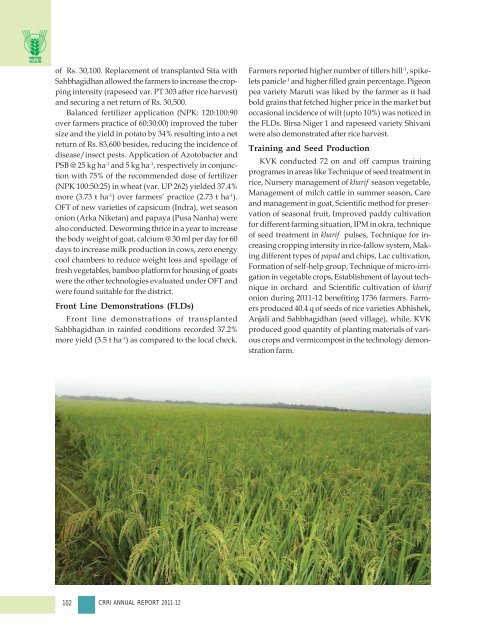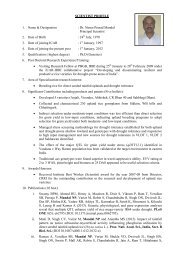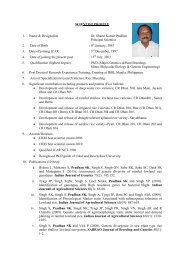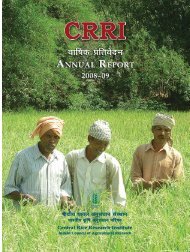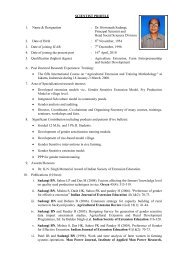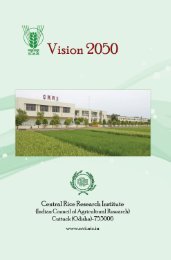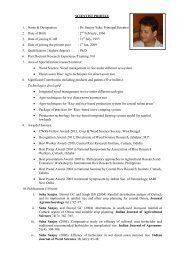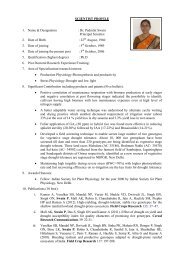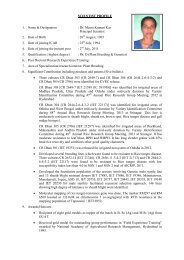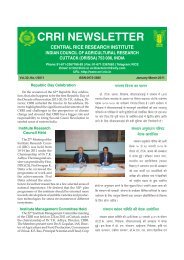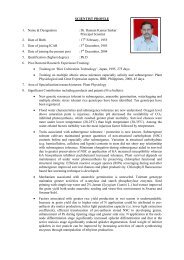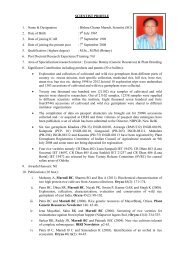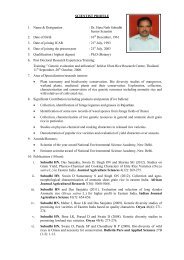Central Rice Research Institute Annual report...2011-12
Central Rice Research Institute Annual report...2011-12
Central Rice Research Institute Annual report...2011-12
Create successful ePaper yourself
Turn your PDF publications into a flip-book with our unique Google optimized e-Paper software.
of Rs. 30,100. Replacement of transplanted Sita with<br />
Sahbhagidhan allowed the farmers to increase the cropping<br />
intensity (rapeseed var. PT 303 after rice harvest)<br />
and securing a net return of Rs. 30,500.<br />
Balanced fertilizer application (NPK: <strong>12</strong>0:100:90<br />
over farmers practice of 60:30:00) improved the tuber<br />
size and the yield in potato by 34% resulting into a net<br />
return of Rs. 83,600 besides, reducing the incidence of<br />
disease/insect pests. Application of Azotobacter and<br />
PSB @ 25 kg ha -1 and 5 kg ha -1 , respectively in conjunction<br />
with 75% of the recommended dose of fertilizer<br />
(NPK 100:50:25) in wheat (var. UP 262) yielded 37.4%<br />
more (3.73 t ha -1 ) over farmers’ practice (2.73 t ha -1 ).<br />
OFT of new varieties of capsicum (Indra), wet season<br />
onion (Arka Niketan) and papaya (Pusa Nanha) were<br />
also conducted. Deworming thrice in a year to increase<br />
the body weight of goat, calcium @ 30 ml per day for 60<br />
days to increase milk production in cows, zero energy<br />
cool chambers to reduce weight loss and spoilage of<br />
fresh vegetables, bamboo platform for housing of goats<br />
were the other technologies evaluated under OFT and<br />
were found suitable for the district.<br />
Front Line Demonstrations (FLDs)<br />
Front line demonstrations of transplanted<br />
Sahbhagidhan in rainfed conditions recorded 37.2%<br />
more yield (3.5 t ha -1 ) as compared to the local check.<br />
Farmers <strong>report</strong>ed higher number of tillers hill -1 , spikelets<br />
panicle -1 and higher filled grain percentage. Pigeon<br />
pea variety Maruti was liked by the farmer as it had<br />
bold grains that fetched higher price in the market but<br />
occasional incidence of wilt (upto 10%) was noticed in<br />
the FLDs. Birsa Niger 1 and rapeseed variety Shivani<br />
were also demonstrated after rice harvest.<br />
Training and Seed Production<br />
KVK conducted 72 on and off campus training<br />
programes in areas like Technique of seed treatment in<br />
rice, Nursery management of kharif season vegetable,<br />
Management of milch cattle in summer season, Care<br />
and management in goat, Scientific method for preservation<br />
of seasonal fruit, Improved paddy cultivation<br />
for different farming situation, IPM in okra, technique<br />
of seed treatment in kharif pulses, Technique for increasing<br />
cropping intensity in rice-fallow system, Making<br />
different types of papad and chips, Lac cultivation,<br />
Formation of self-help group, Technique of micro-irrigation<br />
in vegetable crops, Establishment of layout technique<br />
in orchard and Scientific cultivation of kharif<br />
onion during 2011-<strong>12</strong> benefiting 1736 farmers. Farmers<br />
produced 40.4 q of seeds of rice varieties Abhishek,<br />
Anjali and Sahbhagidhan (seed village), while, KVK<br />
produced good quantity of planting materials of various<br />
crops and vermicompost in the technology demonstration<br />
farm.<br />
102 CRRI ANNUAL REPORT 2011-<strong>12</strong>


